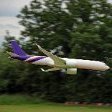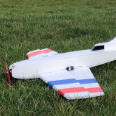Leaderboard
Popular Content
Showing content with the highest reputation on 05/04/24 in Posts
-
Well, it's almost ready to test fly (again) when the weather improves - so not this weekend, I suppose. We're lucky that the Ashbourne airfield site is flyable with a tarmac runway because our 'new' site is almost submerged. So, I've gone from this : To this, with a few weeks of labour and anguish : The CoG is just about where it was originally but it weighs 15 grams more, which is disappointing as I was hoping for lighter. The fuselage is just about all new except for the firewall, cowl, spinner, wing bolt mount and undercarriage. The fin/rudder and tailplane/elevator were almost unscathed. The salvaged parts were little more than dirty, which is a benefit of the ground's being so soft and water-logged off the runway itself. I was able to salvage the covering enough to make patterns for the 'windows' but the yellow/red/orange decoration was a lost cause. To give some visibility I added some chequered covering, which looks reasonable, I think. I will spend an hour or so setting up/checking the throws but, apart from that, it's ready to go.6 points
-
Whilst I moved over from IC to electric flight a few years ago I'm sure that IC will remain a viable option for those that prefer that motive power. While cars replaced horses, we still have horse riding. Railways usurped the canals but we still have an active inland waterways life. Internal combustion replaced steam but we still have traction engine rallies The world is ever changing but there is always room for those that hanker after an older technology.6 points
-
Rich - there is NO POSSIBILITY that the production of methanol would be featured in a cookery programme. It is a nasty poison, ingestion and even significant skin contact leading to damage to the optic nerve, blindness, brain damage or death. There is little likelihood of methanol becoming scarce - it’s widely used in industry, as is nitromethane. Can we please drop this diversion and return to the topic of model aircraft engines.5 points
-
I have finished covering the Tempest and would recommend not trying to cover the whole fuselage side in one piece . There are a lot more curves on the Tempest compared to the 190 , so its fine to take the covering in bite-size chunks . I never worry about the brown paper joints. In fact I'm proud to say that you would all be pretty horrified at my brown paper finish on this model ! The point I am making is that this model is a quick build and will earn its keep . Its no Hanger Queen . However, I hope to show you that despite a woeful lack of care and preparation before painting , we can still pull off a bit of a looker . I can see Paul cringing and Graham R wringing his paws . Have a good look at the hastily and scantily applied white . I'm particularly impressed with the all time low Ive achieved . The thing is , we are going to ............. camouflage it . Consequently , from 5 feet away , you wont see it . Good isnt it ?4 points
-
Pedantry I know, but electric motors are the older technology, 1820 and 1860 (ish)4 points
-
Did Primrose valley one year, had assistance & some training from the Ghost Squadron guys, John & one of the others. Did Brean Sands one year and flew off the beach. With Primrose we had our touring caravan there, but at Brean Sands we used a chalet which was really grim, dirty, poorly maintained you name it. Side story is on the way back from Brean we saved a guys life. We had a big box trailer on my Granada Estate to give more room. We're ambling along in lane 1 of the M4. Suddenly I spot a guy collapsed by an emergency phone. The phone was out of order, so we phoned 999 on my shiny new mobile. Put a coat over the guy as he was very poorly. Paramedics & plod were there pretty quick. It turned out he was diabetic & felt a hypo starting, so stopped near an emergency phone & then collapsed . The phone was out of order. His body temp was very low, it was getting dark, I reckon he'd have been toast if we hadn't seen him. It was only because we were doing 45-50MPH that I spotted him. Any faster I wouldn't have seen him.4 points
-
After a protracted wait, the weather eventually decided to cooperate in providing suitable painting conditions. The cowl was given a couple of coats of 2K primer, rubbed down and then KlassKote colour applied. The colour had been mixed from other standard tins, fortunately some of the paint from the earlier restoration had been saved . The difficult bit was mixing the (Part B) catalyst so that the dried paint had the same sheen as the rest of the model - I wish I had written down what I did earlier. After 4 attempts (and 3 rubdowns) this will have to be near enough. The radiator shutters, rockers and exhaust should be easier as there isn’t a requirement for matching. Everything will be in 2K paint to resist glow fuel attack.4 points
-
I've used two simple methods on the stripes so that you can choose what suits you . The first method was to just go over my pencil lines with a black sharpie pen , then simply paint up to the line . Straight forward really . If you are feeling confident in your masking tape (green Frog tape is very good ) , you can try a different approach by masking off the white areas and then brushing black quickly over the lot . Either method works . The first method might suit those of a more nervous disposition .3 points
-
3 points
-
Zeee Power https://www.amazon.co.uk/Zeee-4000mAh-Battery-Airplane-Helicopter/dp/B089YNLCVG3 points
-
HI, I posting the reply I received from Peter Denison on the questions I had for him on his CM plans Swordfish build. Peter also sent these photos. So the ailerons work fine . I glassed the front sheeted Balsa part of the fuse and used Solartex for the rest then painted . 8. Any improvements you would suggest? Yes cutting back on the dihedral as helped as it’s not a glider is it ! It’s a bit overweight but it flies as slow as i want it to with no problems ,though I don’t fly it if the wind get up , as I have other models for that 🙂 It’s an interesting model to make am sure you will enjoy it . Keep in touch Ken if you have any other questions no problem , I will send over some building photo's. Kind Regards Pete .3 points
-
Yeah I came close to it but in the end thought I’d try not to over complicate it for myself! Looks good with a retract though.2 points
-
Spent a lifetime designing methanol production plants, they typically produce 3,000 to 6,000 tonnes per day, but the minimum order quantity needs a small tanker (ship tanker not lorry tanker) to collect it with if you order direct.2 points
-
Looking at the plan it was a castoring tail wheel, but I’d rather it was steerable… there’s not much room at the back but a I was able to hook the tail wheel to the rudder pushrod.2 points
-
Bad luck Toto but, to be fair the forecast for this weekend is pretty grim anyway - it's been snowing and raining here all day and the winds and rain forecast for the weekend makes any flying unlikely.2 points
-
Doesn't the issue of IC engines continuing to be available to our hobby simply rest upon somebody's motivation to manufacture them? Apologies for stating the obvious. The motivation? A viable, growing market to sell the products to in quantity, and at a margin that makes the whole venture worthwhile and profitable. A mixed bunch of products from the throw away varienty (well almost) through the mid ranges and than the top of the market complex products for the aspiring types. We used to have that twenty or thirty plus years ago, but no more. Clearly, the Chinese manufacturers who really did a wonderful job of producing a wide range of affordable and perfectly good engines had their motivation drained from them. The likes of ASP, SC and a few other smaller brands, must have sold millions of engines to a world wide audience, but dropped them like a hot brick and in short order. I wonder what those firms are doing now - the tooling investment must have been vast to produce such a huge range of engines even with the much reduced cost of Asian manufacturing. OS and Saito must be facing a similar problem - their range is a shadow of its former self and the cost of their products is much increased. As far as I'm aware the Indian manufacturers don't seem to be interested in filling the void. They're not fools, they know the sales are just are no longer there in the quantities needed. The use of IC will continue without a problem in our hobby for quite a few years yet - mainly driven by older modellers recycling older engines and bringing old shed stock back into use, I suspect - but when age etc finally does catch up.....then what? Does it really matter anyway? Enjoy it while you can.2 points
-
Carbon tetrachloride, now that is a dangerous stuff. Used mainly in small pump action fire extinguishers found in cars and lorriesof the day. Its use was banned in these extinguishes due to it releasing phosgene and free carbon if it hit red heat metal . We were taught this in the Fire Brigade and to be very careful with its use on small car fires. It was easily obtainable and used as you say for degreasing. Plating companies used tanks of it to degrease bits . We even used it to thin paint for spraying ! Then it was discovered how dangerous it was and caused liver disease .2 points
-
Don't worry about the boys, there too busy playing with their dollies to care😝2 points
-
Glue looked dry-ish so decided to take a look. Very excited about this - looks promising. Very rigid and only 160g - pretty good!2 points
-
Excuse me chaps, but aren't we supposed to be talking about model aeroplanes and their propulsion methods ?2 points
-
To be honest I wasn’t intending to build something quite this big, but it didn’t look as bad on the laptop screen… 😳1 point
-
Richard took the same electrical course in wiring as me. It was held in a spaghetti factory1 point
-
They dont need to be that brilliant , but please get them straight , otherwise you will hate it . I was a little more careful on the top surface ! The fuselage is masked on the sides first , then across the top and bottom so that the stripes look straight from above . You can see that with a full set of stripes , there isnt that much of the plane left to paint ! The black canopy is only for temporary amusement . This kind of camo is quite straight forward and a useful lesson for the future . The basic premise is that the light paint should be applied first . So its on with the white . If we didnt have decals ( we do ) we would also put white circles where the roundels would be . Yellow rings are also an issue , so we might provide a white base for them too. The big mistake some people do is paint the plane green and grey , then try to paint pale coloured squadron codes on top . Ten coats and three weeks later and they are still cursing .1 point
-
1 point
-
I have an Ender 3 V2 and it's cheap & cheerful. Not as fast as some printers out there but spares and upgrades are easy to source and the popularity of the printer means you can easily get help if you get stuck. There is a learning curve to owning and using a 3D printer. so. it pays not to buy one that only 4 people in Myanmar have bought. KB1 point
-
So my postie did manage a delivery albeit on Thursday. I have now built the first one from my first batch of PCB's for the ESP32C3 super mini ( I always find revisions to make after pressing the buy button!) It all works ok ...... eventually. It took a day of pis**** messing about and eventually fixed a problem with SoftwareSerial not working when the RXPin is set to pin 2 as per my boards, I think it has something to do with pin 2 being the hardware UART2 RX pin and software serial simply refused to recognise the incoming packets on pin 2. The workaround was to not use software serial and use hardware Serial1 instead on pins 2 and 3 - problem solved. After a couple more tweaks on the sketch I am happy it all works as intended. Everything is here1 point
-
I recently 'upgraded' from my trusty Prusa M3S to a Bambu Labs X1 Carbon. It is a very nice machine, not exactly plug and play but once various filament settings dialled in it is extremely good (and v quick!).1 point
-
Officially ..... no chance ..... regardless of weather, we share East Fortune facilities with motor bike racing fraternity who have full use of the area this weekend so ....... it was never a goer. .... there is always next weekend ...... Where's me paint brushes. .... Toto1 point
-
Lipo Man That is very neat. However with a 6mm foam skin I do wonder how much work the spar will be doing apart from stopping the skin sagging between the ribs when it is under tension and buckling when under compression at the point of maximum stress. Alternatively you could argue that if the box spar is the primary source of strength than what is all that skin foam doing? Technically a box spar is used where torsional rigidity is required as well as bending strength however it is quite likely the "all over" 6 mm foam skin will actually provide all the torsional rigidity required thus making the box element of the spar redundant. I do appreciate there are construction benefits in having a box to work from but with such a thick skin I always worry how much stiffer or alternatively lighter any spar would be if it was flush with the outer surface of the foam skin. You can see where this sort of thinking lead me with foam wing construction. I too will be interested in how it pans out.1 point
-
Since Bamboo Labs hit the market it has slaughtered the price of second hand Prusas' Market so some good deals on Ebay for these, We have a mixture of Bamboo printers here working night and day and the Mk 3 Prusas' generally dont get used much now, They are not as sturdy as a Prusa but the prints generally work time after time, AS far as plug and play Bamboo are the closest you will get.1 point
-
I blame their trainer, their spoilt and lack discipline.1 point
-
Yes, a combination of throttle setting and prop when I've played around with a friend's over powered vintage style model. Master Airscrew props are intrinsically less efficient than other makes so might be worth experimenting with. They are easy to cut down with care, and providing they're balanced well each time, you could try a certain amount of cut-and-try to get the performance you're looking for. Either that or a big box of props!1 point
-
1 point
-
15 x 4 will work, just make sure the throttle cut works. Occasionally the efficiency of the big prop produces enough power to keep the thing aloft. You can also try differential on the throttle, so it’s less sensitive in the positions you are flying in, so reducing workload.1 point
-
1 point
-
Much easier than it looks. If you were to go Monday to Friday you would be able to fly most days. Contact Manny to choose the best possible dates.1 point
-
Simple jig constructed from the rib “off cuts” to hold the intended washout. Skinned with pre-shaped 6mm foam sheet glued with foaming gorilla glue. I’ve left it all overnight to see how it works - fingers crossed!1 point
-
Didn’t you read the small print? You may only purchase the next kit if you can prove that you have built either the FW190 or the Tempest. Failure to do so renders your order invalid. Please note that any monies hereto forewarned in lieu of dispatch of the next model will be forfeit and you will not be entitled to receipt of a refund because that’s the price you pay for being a smart arse and for trying to jump the progression. If you feel that these terms are unjust and an infringement of your rights as a human being, tough coz them’s the rules and if you don’t like them you are quite welcome to take it up with ‘the boys’, best of luck there.1 point
-
I do chamfer the edges of each plank preferably on both sides so the plank to plank joint is normal to the surface. I use a sanding block with surprisingly coarse (60 grit) paper on it. New paper cuts the foam very easily with low pressure. I hold the plank in my figures and then locally sand the joint surface and when done work along the full length of the plank. It really only requires the block to "kiss" the foam. It does take a bit of practise to be able to judge how much chamfer is required as it changes depending on the radius of the surface the plank is covering. In general I have found it better to slightly under chafer. It does leave a small gap at the surface but that can be easily filled/painted. Acrylic paint is itself quite a good glue for small gaps! Over chamfering leaves a gap on the inside which you may not even see. Such a plank joint is rather susceptible to splitting from handling pressure. It is worth reebering that much of the strength of a planked structure comes from the plank and it joint with its supporting structure. It is twisting that puts load directly on the joint and than only in shear. Glue is good in shear and a plank joint is very long. The new hose glued on with the new printed "short" nose cone. It just needs the glue to fully harden before light sanding, filling and white acrylic paint. The battery box has been extended to allow the battery to more forward.1 point
-
I completely flatten them with headlight bulbs, then I connect the two leads together to evidence that they are dead and then take them to my local recycling plant which has a battery section.1 point
-
Just my view but I liken those in our hobby that denegrate the ic models as similar in outlook to those who have moved to EV's. They moan about the cost of fuel, tax etc . Shortly after they appear at the field in a new EV having spent thousands of £'s to save a few £'s when their previous car was perfectly ok and in many cases not that old ! A few pounds on fuel and tax is a tiny fraction of what they spent on the new overpriced low range and probably lower quality car and the soon to be introduced tax system and the high cost of public charging. They ovbviously didnt go to school on arithmatic day 😊. Similar story with ic models, unhappy with the cost of fuel , the noise and poĺution etc. Next week turn up with a new electric ARTF with a new batch of expensive batteries costing hundreds of £'s and transported half way round the world with associated tons of pollution ! Just admit it that most of these so called green warriors just want the latest model ,number plate and for the moment free tax or new model.....why? Because they can. If they really cared about pollution then they would use their existing cars and models until they wear out then change. Its all part of our " must have now " culture. Will I go all electric inc EV? No not until I NEED a replacement and if I'm still around perhaps all the lies and hype around electric power just might have died down. Long live IC power.1 point
-
Still waiting for suitable weather but a picture of the X-3 with its long nose. This nose is not flight worthy. It is only for show as apart from any safety considerations the retaining magnets are not strong enough to withstand the likely aerodynamic forces from any pitch or yaw. If and when the X-3 does prove to fly well enough with the bluff nose I could in the privacy on my field tape the long one on just prove it will fly but landing with it undamaged is likely to be a different story.1 point
-
Bill Snap! No magnets yet (they are on order) but top and bottom pegs. Not a problem for the bluff nose but the same will be used for the long one. For the maiden I simply held the bluff nose in place with little bits of Blenderm tape. Yes I have flown it, sort of, twice! It actually has sufficient thrust but proved to be tail heavy. The result is it went into a climb immediately after the launch. With no forced airflow the eelvator has virtually no effect so it stalled. First time little damage, second time even with full down elevator trim it still stalled with rather more damage. As you can see it rather took out all the "sticky out" bits on the right hand side! I later discovered when the RH wing was ripped off the aileron link stripped a gear in the servo too. You can tell how muddy the grass actually was. It will mend no problem. I will move the battery forward and a bit to the left to counter the weight of the ESC. As the thrust appears adequate I will reset the drooped ailerons to neutral as well which should reduce the nose up pitch. My fear is the huge fuselage area compared to the flying surface areas will require the CofG to be remarkably far forward for stable flight. My late Bachem Natter was a bit less aerodynamically extreme and it was a pusher so had adequate thrust. But it still needed the CoG to be at just 16%. Until I set it that far forward every flight ended in an uncontrollable stall. I nearly gave up after 4 rebuilds but once right it flew remarkably well. https://www.youtube.com/watch?v=cq6MzWCXn60&t=30s I can only hope the X-3 gets "sorted" before it gets completely wrecked.1 point
-
I just came across this and thought it was vaguely comparable. Probably double your wing area though 🤔1 point
-
Simon you likely know the full size must have been one of the most marginal aircraft ever, however thought others may be interested in its history. A take off speed of 260mph was needed to get off the ground. Expected to be mach 2 capable it was only able to go supersonic in a steep dive, just not enough jet power from engines of the day. [ some thought was given to use rocket power but this did not happen] Test pilots Bridgeman, Yeagar and Everest found controls to be very sensitive at high speed and sluggish at low speed prompting Everest to say "one of the most difficult aircraft I have ever flown". Pilot used a lift to enter cockpit from below, sort of Thunderbirds style.1 point
-
Ah, Precedent designs. Here's my BiFly 25. Six flights just yesterday. Great fun with the power kept on - glides like a brick, although that makes for nice and steep approaches (even if they are quite fast). Always aerodynamically sound designs. Sometimes unfortunately saddled with die cut (or was it die crushed) liteply, on airframes that were a bit too small to really work well with it, and often accompanied with, how to describe, not the lightest balsa in the shop. So they were often a bit porky, but otherwise good models. If you were prepared to replace some of the timber they could turn out rather nicely. The reported poor flight qualities of their trainers were more down to them being a novice's first build, I think. Nothing wrong with the HiBoy or FlyBoy design. Weren't the Balsacraft offerings were a bit more "premium" than the Precedent line?1 point





















